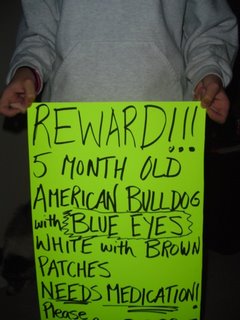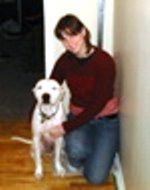The head of the Toronto Humane Society points with pride to the agency's remarkably low euthanasia rate. That achievement, say concerned veterinarians and a respected wildlife agency, may be the problem.
By Andrew Chung
Jun. 18, 2006. 01:00 AM
The historically embattled Toronto Humane Society has come under scrutiny once again as a group of veterinarians raises serious questions about the quality of care the agency provides for the homeless and wild animals under its roof.
The veterinarians, who all worked for the society, other former employees, and unionized workers in the fourth month of a bitter strike, claim animal care is being compromised in a number of ways, including:
-Unlimited admissions to the facility, and maintaining a very low euthanasia rate — going as far as to send unsocialized dogs, which in the past would have been put down, to Chicago for retraining — have contributed to overcrowding and disease;
-Non-domestic animals are not being cared for properly, prompting a wildlife rehabilitation agency to cancel its contract with the society;
-Managers are interfering with professional decisions on euthanasia and adoptability.
An investigation into these and other concerns was launched last year by the Ontario Society for the Prevention of Cruelty to Animals (OSPCA). The results have not yet been released.
This is the first time the veterinarians are going public with their concerns.
Tim Trow, president of the society's board of directors, denies the allegations by these veterinarians and past employees, and says he's proud of how the society is doing.
"We have more public support, more members, more donors, 75,000 of them, more donations than ever. We can intervene more with the animals, afford to care for them more. I'm very proud," Trow says. "Look at the statistics."
Those statistics are prominently displayed on the society's website, where they are contrasted with much higher euthanasia numbers for the City of Toronto's animal centres.
They show that from 2000, the year before Trow was installed as president, to last year, adoptions of dogs and cats at the society increased from 51 per cent to 75 per cent of the animals admitted to the shelter, and the euthanasia rate declined sharply from 43 per cent to 9 per cent.
But looks can be deceiving, argue Trow's critics, of which there appear to be many.
The last straw for Esther Attard came one day last October in the form of a scraggly feral cat. When the veterinarian came into work she saw the cat inside her cage, dead, emaciated and yellow discharge oozing from her mouth and nose.
The cat, Speedy, had been at the shelter for about a month, Attard says, and it was difficult to handle or even touch the wild feline.
Shelter workers had hoped to place her with a cat rescue group, but she caught an upper respiratory system illness, and stopped eating.
Meanwhile, Attard says infection was rampant inside the shelter. It was overcrowded, she says, illness was spreading, and animals were taking much longer to recover. The society's known very low euthanasia rate was contributing to the pressure, she adds.
"It died in its cage overnight," Attard says, "and nothing was done for it. It really suffered unnecessarily."
Shortly after Speedy's death, Attard resigned her full-time position of 11 years.
Two other veterinarians have also left since last summer for similar reasons, out of a full- and part-time veterinary staff of nine. Another veterinarian resigned three years ago.
Many of their concerns mirror those of unionized Teamsters employees, most of whom were employees in direct contact with the animals, who have been on strike over a wide range of issues since Feb. 18.
Veterinarian Carolyn Murray parted ways with the society last December after 14 years, disillusioned and disgusted by what was going on.
"There is more than just numbers," she says. "You have to look at the quality of the care, what was actually happening to those animals."
Because of what some veterinarians say is overcrowding and insufficient staff to clean, feed and treat the cats, viruses causing highly contagious upper respiratory infections and distemper were rampant. Animals have died in their cages, they say.
"There were a lot dying of dehydration, not eating well, stressed, picking up diseases because they weren't receiving the optimal preventative care," Murray says.
A year ago, Murray wrote a letter to the society's board of directors, outlining her concerns. She reported how the room designated for cats with respiratory infections was full, and sick cats were placed in the back hallway. Cages were "filthy with diarrhea, food material and nasal spray," Murray wrote.
The shelter's policy is not to refuse any animals that arrive at its doorstep. That does not make the society unique. Some other shelters also have the same practice.
Given the conditions, however, "if you wanted unlimited intake, you have to have higher rates of euthanasia, if you're not looking after them properly," Murray says.
Another veterinarian, Peter Copeland, resigned in 2003 in part because of the overcrowding, he says.
"As a vet, I didn't have input, to say, `I think we've reached our limit, I don't think we should take any more in.' There were times I was dissatisfied with the care as a result," he says in an interview.
When the OSPCA (which, ironically, has been grappling with its own problems over its mandate) hired investigators to look into staff concerns, Murray was one of many employees interviewed.
Tim Trow sits in a conference room adjacent the main office on the society's second floor. As a volunteer board president, he doesn't have an "office," but staff say he is in this room almost every day.
The retired lawyer sits behind piles of paper, signing cheques for dozens of bills. "It's very expensive running this place," Trow, 60, sighs. In 2004, the latest financial statement available, the society spent $10.7 million.
Outside his window, a vast concrete shell has been laid for the new $2 million Cat Sky House, which, when finished, will hold 380 cats and relieve crowding on the main floor.
Behind the building, Trow has built three new grassy dog parks, with agility-training equipment that even the Toronto Police use with their dogs.
Trow's desire to keep animals alive runs deep and wide. Near the main office, a room has been annexed for the isolation of cats with FIV, the feline version of HIV, waiting for adoption.
Another conference room houses cats that have not been socialized and need special attention. "These animals would have been put down in the past," Trow says.
The shelter is overcrowded, he admits, but limiting animal admissions is not the answer.
"It's a terrible suggestion," he argues. "Should we let them die on the street?"
He blames the city's five animal shelters for not taking in the number of animals they should — one-third fewer animals than the society admitted last year.
The city, meanwhile, says it accepts all strays and surrendered pets that come through its doors. The Humane Society receives more animals because it is better known and publicized, says Ron de Burger, the city's director of healthy environments.
Trow is not overly worried about disease incidence. "There are always diseases in pounds and shelters." He says the animals arrive harbouring disease and don't necessarily pick it up at the shelter. "These are minor respiratory diseases along the lines of a cold."
He also rejects claims that animals are dying. "Far, far fewer animals are losing their lives than before," he says, because of low euthanasia.
In fact, deaths inside the shelter are up, Trow's statistics show. The numbers are small in relation to the thousands admitted each year, but in 2000, the death rate (excluding euthanasia) was 0.5 per cent or 48 animals. In 2005, it was 1.8 per cent, or 170 animals, almost four times more.
This, Trow says, is "because of efforts to save them, rather than saying, `This is a sick animal, we need to euthanize them.'"
So why are the veterinarians making these claims?
"I think they genuinely disagree with trying to save more lives," he says.
A thickly built dog bounds through the room, and soon demands to go outside with a few loud whimpers. "Poor doggie," Trow says. "I feel sorry for him."
This is Bandit, the infamous pitbull/Labrador cross that a Justice of the Peace sentenced to death in October of 2004 for biting three-year-old Daniel Collins in the head and leaving him with 200 stitches.
Despite a court order, the society refused to kill Bandit. It is now appealing the sentence. (A new court date has yet to be set.)
"He's not aggressive," Trow says. "Does he look aggressive to you?"
The society has become a haven for dogs that some consider aggressive. On a recent tour of the facility, many larger pens were filled with pitbull- type canines that barked uncontrollably and jumped at the bars.
The society is more apt to keep these dogs alive, even though aggressive dogs at most other shelters are euthanized. The veterinarians that left the shelter say that in Toronto, many of these dogs languish in the shelter.
That's not the case elsewhere. "If it's an animal that we believe will attack and bite a child, we will euthanize it," says Bruce Roney, executive director of the Ottawa Humane Society, which deals with more animals yearly than does Toronto.
"If we receive a court order to euthanize, we euthanize. The Toronto Humane Society is not doing that.
"Of the larger humane societies across the province and the country, most of us operate very similarly and have similar philosophies and assumptions — except the Toronto Humane Society."
Such is Toronto's philosophy now that dogs with major aggression or socialization problems are even being sent to Chicago for intense retraining. About a dozen dogs have taken this trip, at a cost of about $12,000, Trow says.
`There is more than just numbers. You have to look at the quality of the care, what was actually happening to those animals'
Dr. Carolyn Murray
`If I say to Dr. So and So, "Can you tell me why you believe this animal should be euthanized?" I don't see anything wrong with that'
Tim Trow
Why Chicago? The behaviourist, he ventures, is "the best there is."
"It's very successful," adds Trow, because the behaviourist adopts the dogs out from there "and reports back to us."
When it comes to Bandit, more than one veterinarian interviewed by the Star documented him as unadoptable. They, Trow says bluntly, "were wrong."
Veterinarians complain they are no longer asked to assess behaviour to determine adoptability at the society. Canine or feline services co-ordinators or a behaviourist make those decisions now.
But even those decisions can be overridden, says one employee who left the society recently.
"Decisions on euthanasia were often overruled by management," says the employee, who asked for anonymity because staff had to sign a confidentiality agreement this year.
The employee tells of a cat that was recently returned three times by different adoptive owners for aggression. The cat was recommended for euthanasia. "But it's waiting to be adopted again right now."
Vets are also now questioned about their decisions on euthanasia. Attard was shocked when, after she had euthanized three squirrels last August, she received a letter of suspension from the then-shelter manager.
Though Attard had thought the squirrels weren't thriving and should be put down for humane reasons, the letter stated that the squirrels, in fact, "seemed to be quite healthy," and that wildlife euthanasia required "permission from the shelter manager or the shelter supervisor."
The suspension was eventually quashed after she took it to the senior vet, she says.
"I was devastated that they would think I would euthanize just because. I don't make those decisions lightly. I agonize," Attard says.
"This was management interfering with the veterinary procedures."
Trow counters that management is not doing anything wrong.
"I'm the president, I'm responsible for these animals. If I say to Dr. So and So, `Can you tell me why you believe this animal should be euthanized?' I don't see anything wrong with that."
In Ottawa, management stays out of the picture, Roney says. "There's no permission from me or any others. I'm not a vet. I'm not an expert in animal behaviour. They're trained professionals. I'm a not-for-profit manager."
The Toronto Humane Society's chief veterinarian, Steve Sheridan, didn't return requests for an interview. However, at least two current veterinarians say they don't object to management's interference.
Vivian Unger, for instance, says, "I don't mind speaking to a supervisor" about euthanasia cases. Rob Rock says, "Management helps me do my job."
Unger recently went to Trow to discuss an 8-week-old golden retriever puppy, paralyzed with neurological problems. Trow authorized him to be driven to Guelph to be seen by a neurologist and even to buy a new "cart" — akin to a wheelchair for dogs — a cost of thousands of dollars.
"We had a canine cart here in the building someone had donated to us, and his attitude was, `Don't even think about giving this dog an old cart, get him a brand new one,'" says Unger.
This is the second time Trow has been president of the society. The last time, in 1982-83, a group of directors alleged mismanagement and poor animal care and called for a city investigation. The city ended up taking over its management for a year and assuming control of dog catching.
The society's chief veterinarian at the time, Angelo Filiplic, also shocked the public, saying the society itself "should be charged with cruelty to animals." He said a new foster care program and a policy to no longer kill pregnant or newborn strays was leading to overcrowding and rampant disease, and animals were dying. An independent commission concurred.
Nevertheless, Trow says the commission and Filiplic have been "proven wrong." It was the start of animal foster care, in which animals are placed in homes as they wait for adoption. "Every shelter, every pound, now has foster care programs. Our board was visionary."
Current staff members say that since the strike began in February, management has hired more replacement workers, and the facility is cleaner.
But certain policies are still causing concern. Several former staff members say that animals are being taken in and placed in the adoption room sometimes without screening first by a vet, and that some strays are not being held long enough for owners to come by and find them.
Others are concerned about one of the society's main mandates: to investigate claims of animal cruelty.
Linda Vitarelli, a licensed animal cruelty inspector who is on strike, says her department went from four full-time investigators three years ago to just herself when the strike began.
There is now just one "agent" whose sole job is investigations. Unlike "inspectors," agents can investigate but cannot lay criminal code cruelty charges without an inspector's approval.
Veterinarian Sue Carstairs says there were problems with the wildlife. By the time she resigned from the society last July, she says management had "basically closed" the wildlife centre. Trained staff had either retired or were reassigned, and weren't replaced, Carstairs says.
Sandra Prins, a veterinary technician who resigned last January, says the technicians were asked to take on the wildlife work.
"We had no training with respect to wildlife," she says. "I touched a baby racoon maybe once in my life." She called the unit "an absolute mess. Sometimes there wouldn't be anyone to clean or feed there."
Carstairs says some animals were admitted without seeing a vet. She says her decision to leave was fuelled by seeing baby birds, which should be fed every 15 to 30 minutes, being kept in shoeboxes and fed only three times a day.
"They'll starve to death," Carstairs says.
"When I couldn't do anything to make it better, I decided not to work there anymore."
Trow shows a visitor a courtyard that houses three cages filled with baby racoons. A worker is scooping wet food into a garbage bin.
"Does this look closed to you?" he says with a laugh.
Turning to the employee, he says, "You're not working, I guess."
But a highly respected wildlife rehabilitation agency remains dissatisfied with the care the society is providing to wildlife, and last month decided to cancel a five-figure contract it had with the society to take in wild animals from the charity.
Earth Rangers, based in Woodbridge, Ont., took in the animals. Before being transferred, they were to have been first stabilized — given fluids, or pain medication — at the society.
However, Earth Rangers found that the society was providing improper care of animals, says wildlife director Kip Parker. Animals arrived there from the society that should have been euthanized right away, he says, while others weren't transferred in a timely way. "Many of them had to be euthanized," Parker says.
Parker was one of the first staff members at the Toronto Humane Society's wildlife centre when it opened in the mid-1980s (after Trow's first stint as president). He left the society in 1987.
"When I looked at their program to assess what they were doing, I was distressed. It was now gutted, trained staff had been removed, space had been cut back severely. It's been destroyed. It's disheartening. It makes me extremely sad, and it doesn't provide care for wildlife in the City of Toronto."
For his part, Trow says the contract with Earth Rangers was cancelled on a mutual basis, and that the society was finding it expensive and inconvenient to constantly transport the animals through the city.
The Toronto Humane Society has been plagued by internecine fighting for decades. The dysfunction dates as far back as the 1970s, with boards of directors repeatedly swept from office by "rebels."
After Trow left in the early 1980s, radical animal-rights activists gained control. The society faced an audit by Ontario's Public Trustee and lost its affiliate status with the OSPCA (then the Ontario Humane Society), although that affiliation has since been restored.
In 2001, the city stripped the society of its role as the city pound for stray animals.
It was also during this time that management attempted to implement changes to society bylaws to bring its governance in line with modern standards — and possibly end the dysfunction for good.
Two changes considered vital were term limits and a more stringent separation between the board and shelter management. Term limits would have prevented people from sitting on the board indefinitely, as is the case with some current board members, to ensure fresh ideas, says Bruce Reid, a former board member involved in the changes.
"There were people that weren't contributing to the betterment of the Humane Society but didn't want to leave," Reid says. "It was a bit like the Senate, actually."
But management's attempt to remove voting privileges from general members without telling them ended with a judge invalidating all the changes. Eventually, the progressive board members were voted out, and Trow returned as president.
Most non-profit organizations now have term limits, says Agnes Meinhard, director of the Centre for Voluntary Sector Studies at Ryerson University. Indeed, the Ottawa Humane Society does. Without them, research has shown, "the leadership becomes very possessive and the transparency of what the organization does and what they're doing is compromised," Meinhard says.
Current and former staff now say Trow is heavily involved in the day-to-day operations of the shelter. That's unacceptable for an organization the size of the Toronto Humane Society, Meinhard says, where management should be clearly separated from the board, which is there only to set policies.
Board presidents should restrict their contact to an executive director — in this case, the shelter's three managers. Trow "shouldn't even be even talking to the vets," Meinhard says.
Without such separation, staff might get confused and feel they have two bosses. It's also harder to oversee an organization's finances. "The more you micromanage from a board level, the more dysfunction you can get," she says.
The system is "working fine," Trow responds. "Amending the bylaws is the last thing we need to worry about here. They work well. They're the members' bylaws, and I'm not going to interfere" with them.
As he shows his visitor the adoption cages in the shelter, Trow beams when he talks about how the place has evolved. He says that in the 1920s, nearly 100 per cent of the cats brought in were killed. Now it's the opposite.
Trow walks past an isolation room housing a dog whose intestines are rife with the debilitating parvovirus.
"You see?" he says, peering through the small window. "We can save him."






